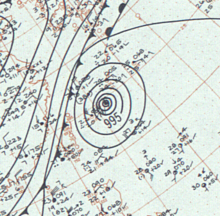 Surface weather analysis of Typhoon Emma on November 12 | |
| Meteorological history | |
|---|---|
| Formed | November 1, 1959 |
| Extratropical | November 13, 1959 |
| Dissipated | November 15, 1959 |
| Unknown-strength storm | |
| 10-minute sustained (JMA) | |
| Lowest pressure | 960 hPa (mbar); 28.35 inHg |
| Category 3-equivalent typhoon | |
| 1-minute sustained (SSHWS/JTWC) | |
| Highest winds | 205 km/h (125 mph) |
| Overall effects | |
| Fatalities | 4 confirmed |
| Missing | 2 |
| Areas affected | Guam • Philippines • Okinawa |
Part of the 1959 Pacific typhoon season | |
Typhoon Emma was a strong typhoon that struck Okinawa during the 1959 Pacific typhoon season. An area of severe weather formed near Kwajalein Atoll on October 30, and the Japan Meteorological Agency (JMA) began tracking it as a tropical depression on November 1. The Joint Typhoon Warning Center followed suit on November 5 after finding a closed circulation, and the depression received the name Emma. The depression strengthened into a tropical storm west of Guam on November 6 and gradually gained strength. Emma became a typhoon on November 11 near Luzon, and it reached its peak sustained winds of 205 km/h; 125 mph (110 kn) later that day. The typhoon turned northeastwards and grazed Okinawa the next day. Emma steadily weakened and became extratropical on November 13, and the JMA ceased tracking the storm on November 15.
On November 12, Emma caused significant damage in Okinawa, compounding the effects of Typhoon Charlotte in October. Heavy rainfall and strong winds were reported on the islands, flooding the city of Naha and blocking access off to it due to landslides. Shops in the city lost thousands of dollars in merchandise, while crops in the territory were damaged. Minor damage was reported at American military installations, such as Kadena Air Base, where the total damage was worth US$219,586.50. Four people were killed during the storm, and two more were missing. Wind and rain were reported in Guam and the Philippines, and several ships were damaged or sunk by the storm.